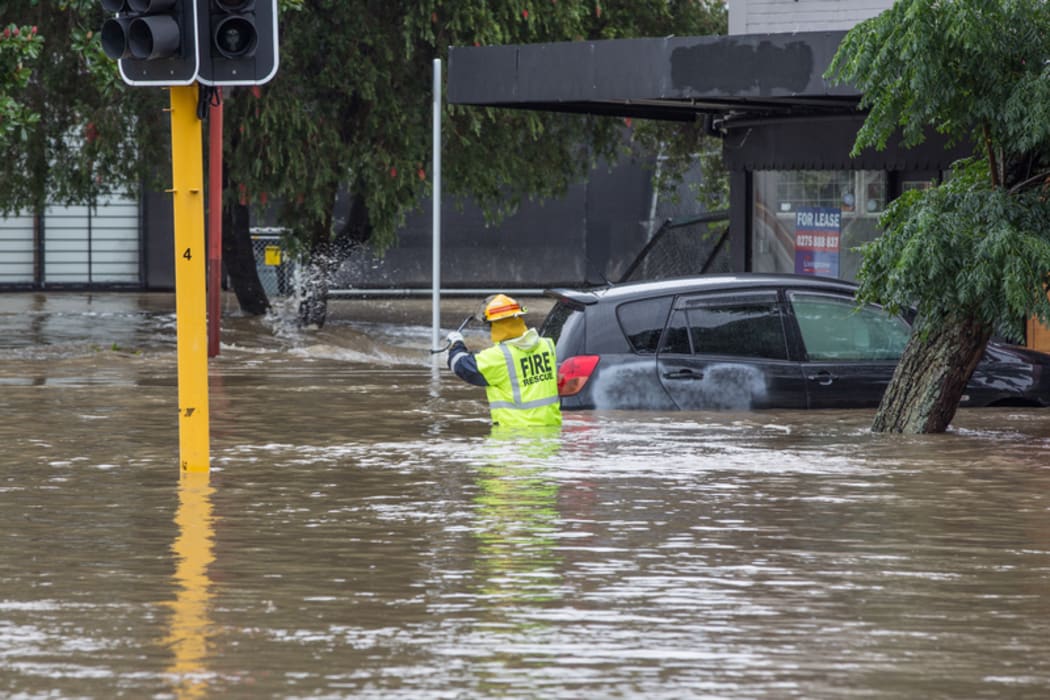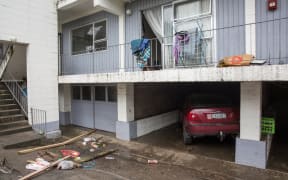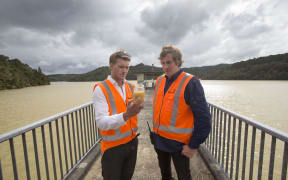The deluge that flooded hundreds of Auckland homes shows the city's infrastructure is no longer fit for purpose, and it cannot even cope with smaller weather events, critics say.

Flooding in New Lynn: More than 320 homes were affected by the weekend's flooding, including more than 220 in West Auckland. Photo: RNZ / Cole Eastham-Farrelly
Infrastructure NZ says wastewater and stormwater systems in the region could need up to $20 billion of work.
A wastewater biologist, meanwhile, says partially-treated or untreated wastewater is pumped into Manukau Harbour more than 20 times a year on average, because the city's largest treatment plant cannot cope with large rainfalls.
Auckland Council says it has upgrades planned for wastewater and stormwater systems but cannot fix them overnight.
More than 60mm of rain fell in West Auckland in one hour yesterday, flooding homes in New Lynn, Glendene and Kelston.
Many of the homes that were flooded - some up to waist-deep - were inundated because stormwater drains could not cope with the downpour.
Upgrades estimated to cost up to $20bn
Infrastructure NZ chief executive Stephen Selwood said rainfall like that on Sunday "blows the system apart" - but the city's infrastructure was not even coping with smaller amounts of rain.
"Even on a normal basis we've got combined stormwater and wastewater systems that overflow into each other ... which means you end up with wastewater in the stormwater system."
He estimated the cost of bringing infrastructure up to scratch would be $15-20bn over 30 years.
"I know that Watercare have in excess of $5bn in capital works planned."
Wastewater biologist Gemma Tolich Allen said attention had focused on the Ardmore Water Treatment Plant, which was clogged with silt by the days-long downpour, prompting Watercare to ask Aucklanders to cut their water use by 20 litres a day until the end of March.
But she said the volume of water entering the Mangere Wasterwater Treatment Plant - Auckland's largest - was likely to have exceeded 16.5 cubic metres per second.
At that point, the water was not even screened, meaning solid faecal matter was likely to have been pumped into Manukau Harbour, Ms Allen said.
"I think [the amount] will just absolutely shock Auckland."
That was not even a rarity, she said.
Once water entering the plant exceeded nine cubic metres per second, it bypassed part of the treatment system. That happened 20 to 22 times a year, Ms Allen said.
"Watercare terms an 'event' as any instance of sustained bypass."
That could range from several hours up to more than a day.
Residents not warned of flood risk
For the second time in five years, six ground floor units at 4116 Great North Road in Glendene flooded yesterday after a nearby stormwater drain failed.
Shivani and Gobind Juneja moved into their unit just three weeks ago, and chose not to get insurance because they could not afford it.
Yesterday they lost their car, scooter, and most of their other possessions, including furniture.
"If the landlord or anyone, the manager, [said] to us, 'This is a flood-affected area,' we'd know to take out insurance. But nobody guided us," Gobind Juneja said.
There was no mention of the property being flood-prone in a tenancy agreement Mr Juneja showed to RNZ.
Auckland Council said the stormwater drain at the back of the property was "a known hotspot for blockages so is cleared fortnightly and prior to 'weather events'".
"We cleared this drain of debris and rubbish on February 28, March 2 and on March 10 prior to the latest round of severe weather," Auckland Council general manager of healthy waters Craig McIlroy said.
Wellpark Trust director Philip Davis said he was not aware the property was a flood risk.
The 2012 flooding was the result of a blockage in the stormwater pipe, not a failure to cope with torrential rain, and he was not aware the pipe was a "known hotspot", he said.
Mr Davis said he would warn all future tenants of the risk.
Council has 'doubled' spend on stormwater upgrades
Auckland Mayor Phil Goff, who spent the day in West Auckland surveying the damage, said the council should know in the next few days what had caused the flooding.
The Salvation Army and other groups were helping families who had lost their possessions and homes, he said.
"We should know in the next day or so what the cause of the blockage was. Sometimes it's because there's a grill across the culvert - and when you get a deluge, a water bomb, what it does is it washes everything ... and then it clogs the grill.
"[But] you've got to have the grill in place because otherwise kids would get into the culvert and lives would be at risk."
Auckland Council chief operating officer Dean Kimpton said information about flood-prone areas was publicly available to prospective homeowners, or renters could enquire with their landlord.
The council was renewing water systems in some of the oldest parts of the city, where infrastructure was a century old, he said.
"We have doubled the spend on stormwater renewals - so that's getting in and sorting out some of these pipes that are undersized."
It was a "massive" investment and the council had to prioritise where it spent money.
"We think about risk across Auckland and where to best focus that renewal."




